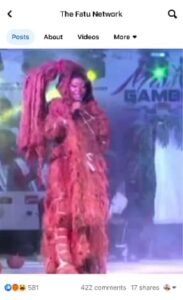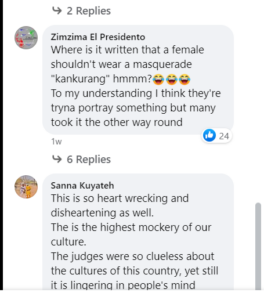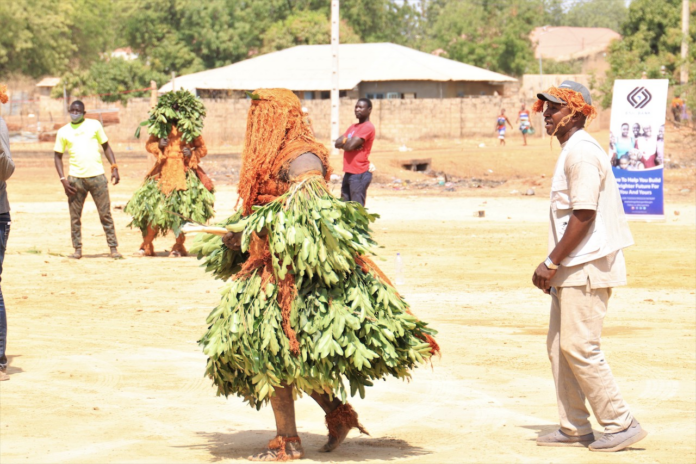By Dawda Baldeh
The Kankurang masquerade is one of the famous cultural practices observed by many in The Gambia. During the Miss Gambia Pageant held on Friday, December 30, 2022, at the Coco Ocean Hotel, a lady was seen dressed in a Kankurang masquerade regalia during a pageant.

This spectacle has sparked a lot of controversies. A Facebook post, tagged “opinion” by Fatu Network, condemned the lady for wearing masquerade regalia, describing it as “disrespectful to the Mandinka Culture.” That post has generated over 422 comments, 580 engagements, and 17 shares at the time of conducting this fact-check.
Another Facebook user, Badibunka A.K.A Jawaro, said, “This is a total disrespect to our culture and sabotage; why should they allow such to happen? If you don’t know your culture and its roots, this is what it lead(s) you to, (I) am heartbroken seeing this Allah, Yalong [sic].” But others like Modou Drammeh have a contrary opinion.
“Belie, this country (is) full of comedians! Kankurang is a Kankurang whether male or female; there is no law whatsoever that says only men should put on the masquerade. Let these fanatics chill and know that culture doesn’t belong to anyone’s father,” Drammeh fired.

Other comments from the post suggest that the masquerade is not for the Mandinka ethnic group only, raising questions about who owns it and who decides how it has evolved.
The two concerns raised were which tribe in Gambia the Kankurand masquerade belongs to and if women wear the attire of the Kankurand masquerade.
Against this backdrop, DUBAWA examined the issues by finding out from experts the facts behind the cultural practice.
What is Kankurang?
The term Kankurang is a combination of the Mandinka words ‘kango’ and ‘Kurango’, which literally translate as “voice” and “enforce,” respectively.
The masquerade wears a mask made of the bark and red fibre of the ‘faara tree,’ and there are three different types of Kankurang in the manding societies, which include,
- Ifangbondi, who is invisible to the human eye and acts to shield boys from evil during the night time.
- Jamba, a masked dancer responsible for ensuring that the community’s life is orderly and disciplined through his enforcement. This type can be seen at social occasions such as weddings and age-grade initiation ceremonies.
- Wulengo, who is supposed to protect circumcised boys from evil spirits, wicked people, and witchcraft UNESCO.
The Kankurang initiate is clothed in leaves, and his body is painted with vegetable dyes. This is associated with circumcision ceremonies and initiatory rites.
Firstly, we sought to find out if, in Gambia, the Kankurang masquerade is a culture for only the Mandinka tribe.
Who does the Kankurang masquerade belong to?
Kausu Drammeh, a Gambian history and political science specialist based in the United States, said, “Kankurang masquerade is a culture known only for the Mandinka tribe.
“Masquerade is purely for Mandinka and is displayed by men,” he said.
Sulayman Ceesay, a Gambian cultural ambassador based in Sweden, also confirmed that the Kankurang masquerade is “purely for the Mandings (Mandinkas) and is for men. I grew up in a community and region known for masquerade, but it never happened,” Mr Ceesay added.
In a UNESCO research report conducted to preserve the cultures of different tribes in The Gambia, it was discovered that the Kankurang is an initiatory rite practised in The Gambia, in the Manding provinces.
The Gambia information site also states on its website, “The Kankurang is a secret society of traditional masquerades, used in traditional Mandinka circumcision and initiation rites, whose rituals can be seen all over The Gambia.”
A publication by The Point Newspaper Gambia also confirms that the Kankurang is tied to the Mandinka communities in the Gambia.
We can then conclude that in Gambia, the Kankurang masquerade is a cultural practice only for the Mandinka (Manding) tribe.
Secondly, we inquired about women wearing the Kankurang masquerade costume because some comments on the post suggested they couldn’t.
Do women traditionally wear the Kankurang masquerade costume?
Ebrima S. Sanneh, a History and Geography teacher at the Gambia College, also said that “I have never seen a female Kankurang in my life, and I grew up in a region that practices Kanjurang every time.” The Kankurang masquerade guides initiated boys in communities and disciplines people.”
On the other hand, in a report published by the Voice of Gambia, Hassoum Ceesay, Director General of the National Centre for Arts and Culture (NCAC), is quoted to have described Kankurang as “a highly respected and valued aspect of the Senegambia culture and heritage which is a Manding masking tradition that dates back hundreds of years.” He, on the other hand, said in a 2023 report published on theeastafrican that “while it is unclear, it wasn’t wrong for the female contestant to wear it during the beauty pageant. I believe the intention was great. The intention was to showcase our culture and heritage.”
There is no evidence of the rightness or wrongness of women cladding themselves in Kankurang costumes. But it is clear that the Kankurang masquerade tradition belongs to the Mandinka ethnic group of The Gambia.
”The researcher produced this fact-check per the DUBAWA 2023 Kwame KariKari Fellowship partnership with (The Fatu Network) Daily Trust to facilitate the ethos of “truth” in journalism and enhance media literacy in the country.”




